
Introduction to Kingfishers
Welcome to the vibrant and fascinating world of kingfishers! These birds are not just about that flash of brilliant blue that might catch your eye as it zips along a riverbank. They’re a diverse group, belonging to the family Alcedinidae, and they have a lot more to offer than just their stunning looks.
When you picture a kingfisher, you’re probably thinking of a bird with bright plumage, a large head, and a hefty beak, perfect for fishing. That’s a pretty accurate image for many of them, but did you know that not all kingfishers actually fish? In fact, these birds come in a variety of shapes and sizes and occupy a range of habitats far beyond just rivers and lakes.
Kingfishers are found all over the world, from the tropical rainforests to arid deserts. While some are indeed expert fishers, diving with incredible precision to catch their aquatic prey, others prefer hunting insects, small reptiles, or even small mammals. This adaptability to different environments and food sources is one of the many remarkable traits of kingfishers.
Their vibrant colors aren’t just for show either. Depending on the species, these colors can range from the brightest blues to greens and even shades of orange or red, often used for attracting mates or signaling their territory.
But beyond their physical beauty and hunting prowess, kingfishers have a certain mystique about them. They’ve been subjects of art, folklore, and literature across various cultures, symbolizing peace, prosperity, and even love in some traditions.
In this in-depth exploration, we’re going to dive into all these aspects of kingfishers and more. From their unique physical characteristics to their significant role in ecosystems and cultural symbolism, we’ll uncover the many layers that make kingfishers so intriguing. So, get ready to embark on a journey into the world of these remarkable birds!
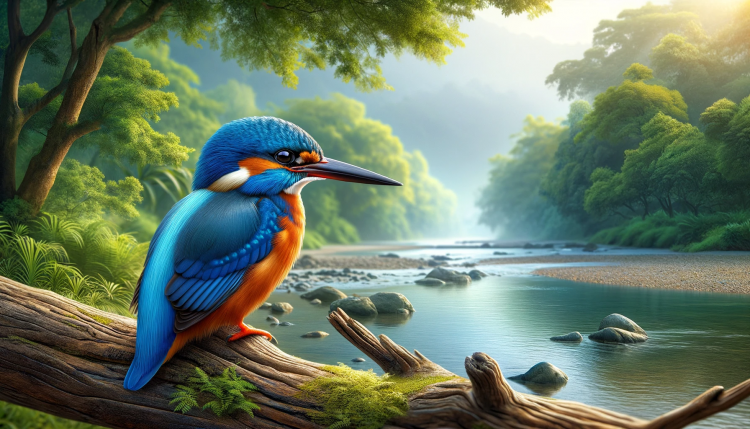

Physical Characteristics and Distribution
Now, let’s get a closer look at these feathered jewels. Kingfishers are a bit like nature’s masterpieces, each species adorned with its unique set of colors and features. The most common image that springs to mind is probably that of a bird with a sturdy body, short legs, and a large head topped off with a long, sharp beak – perfect for their predominantly piscivorous (fish-eating) diet. But that’s just scratching the surface!
A Rainbow of Colors: Kingfishers come in a dazzling array of colors. The most famous, perhaps, is the iridescent blue of the Common Kingfisher found across Europe and Asia. But there’s also the fiery orange of the Rufous Kingfisher, the striking green and blue of the Amazon Kingfisher, and many more. These colors aren’t just for show; they play a role in camouflage, mating, and territorial displays.
Size Matters (Or Does It?): When it comes to size, kingfishers vary significantly. The Giant Kingfisher, living up to its name, can reach up to 45 cm in length, while the diminutive African Dwarf Kingfisher is just about 10 cm long. This variation isn’t just random; it’s closely related to their habitat and diet.
Where in the World: Speaking of habitat, you might be surprised to learn just how widely distributed kingfishers are. They’re found on every continent except Antarctica, adapting to a wide range of environments. Some, like the Belted Kingfisher in North America, stick to the waterways, while others, such as the Shining-blue Kingfisher in Southeast Asia, prefer dense rainforests. Then there are species like the Red-backed Kingfisher in Australia, making a home in arid deserts.
Adaptation is Key: These diverse habitats have led to some fascinating adaptations. For instance, the fishing kingfishers have developed incredible eyesight to spot their prey from above the water, along with strong and streamlined bodies ideal for diving. Meanwhile, forest-dwelling kingfishers have honed their agility to dart through trees and catch insects on the wing.
The distribution and physical characteristics of kingfishers are a testament to their adaptability and resilience. As we move through different environments across the globe, we see these birds thriving in conditions that vary from the tropical heat of the Amazon to the cooler, temperate regions of Europe. Each species has its unique adaptations, making the kingfisher family a wonderful example of nature’s ingenuity and diversity.
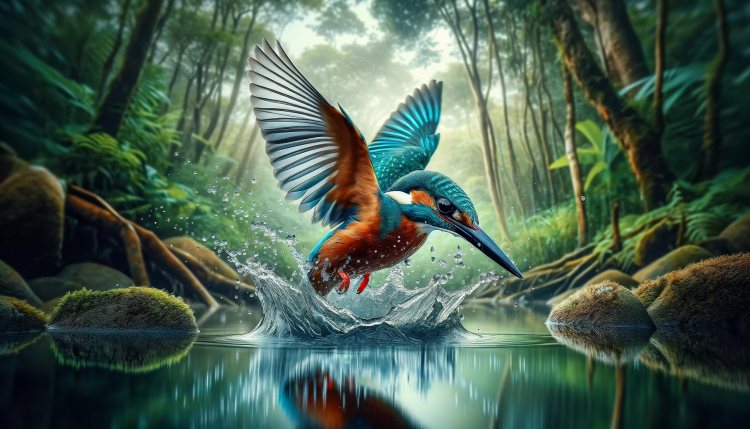

Behavior and Diet of Kingfishers
Let’s dive into the daily lives of kingfishers and see what’s on their menu. You might picture them as solitary hunters, perched patiently over water, ready to dive in for a fish. And while that’s true for many, there’s much more to their behavior and diet.
A Diverse Palate: Kingfishers’ diets are as varied as their habitats. The classic image is of a bird skillfully catching fish, but many species have a more eclectic taste. Insects, small reptiles, amphibians, and even small mammals are on the menu for some. The Laughing Kookaburra of Australia, for example, is known for its hearty appetite for snakes and lizards.
Masters of the Hunt: Hunting techniques are a marvel in themselves. Those specializing in fish have remarkable precision. They can calculate the refraction of light in water to pinpoint their prey, diving in with incredible speed and agility. Others, like the forest-dwelling kingfishers, exhibit impressive aerial acrobatics to snatch insects mid-flight.
Solitary but Sociable: Kingfishers are generally solitary when it comes to feeding, fiercely guarding their hunting territories. However, they can be quite sociable outside of feeding times. Some species, like the kookaburras, are known for their family groups and communal roosting habits.
Communication and Courtship: These birds aren’t just visually stunning; they’re also quite vocal. Their calls range from the melodic trills of the Common Kingfisher to the loud, laughing call of the Kookaburra. These sounds play a crucial role in territory marking and mating rituals. Speaking of romance, kingfisher courtship often involves gift-giving, usually in the form of a tasty fish or insect.
Seasonal Behaviors: Kingfishers’ behavior can also change with the seasons. In regions where water bodies freeze over in winter, some kingfishers will migrate to find open water. Others adapt by switching their diet to more readily available prey, like insects.
In the world of kingfishers, life revolves around their next meal. Whether it’s a solitary Common Kingfisher expertly plucking fish from a stream, a group of Kookaburras laughing in the dawn, or a forest kingfisher darting through the trees, each species has its unique way of life. Their behavior and diet are fine-tuned to their environment, showcasing the incredible adaptability and diversity of these fascinating birds.
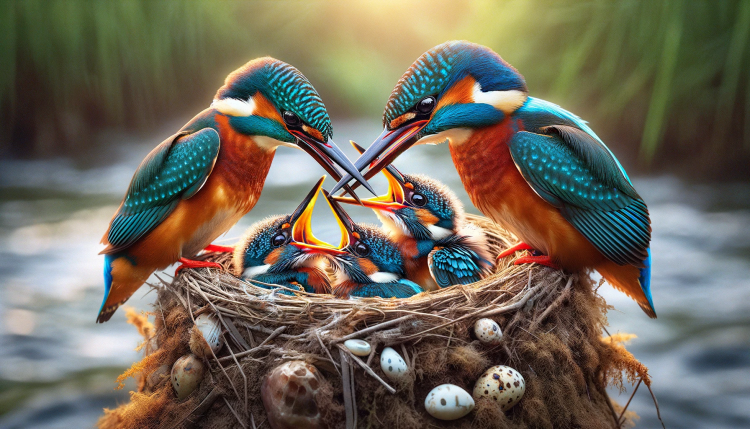

Breeding and Life Cycle of Kingfishers
When it comes to raising the next generation, kingfishers have some intriguing rituals and strategies. Let’s peek into their nurseries and discover how these dazzling birds go about the business of breeding and rearing their young.
Love is in the Air (and Water): The courtship of kingfishers can be quite a spectacle. It often involves elaborate displays, such as aerial dances, diving performances, and the male presenting fish to the female – talk about a dinner date! These rituals not only strengthen pair bonds but also allow the female to assess the male’s hunting prowess.
Nest Building 101: Kingfisher nests are as varied as the birds themselves. Many species, like the iconic Common Kingfisher, excavate tunnels in riverbanks, meticulously crafting a safe and secluded chamber at the end for their eggs. Others may use natural cavities in trees or even termite nests. The choice of nesting site is crucial – it needs to be secure from predators and, for those that fish, close to a steady food supply.
Egg-citing Times: The number of eggs laid varies by species, but generally, kingfishers lay between two to seven eggs. These eggs are often a pearly white and are incubated by both parents. The incubation period can range from around two to four weeks, depending on the species.
Growing Up Fast: Once hatched, kingfisher chicks are entirely dependent on their parents. They’re born blind and featherless, but they grow rapidly. Both parents are busy during this time, bringing a steady stream of food to the nest. Within just a few weeks, these chicks transform from helpless infants into fully feathered juveniles.
Learning to Fly (and Fish): The fledging period is a critical time for young kingfishers. They must master the art of flying and, for many species, learn the intricate skill of fishing. This learning phase is risky but essential. Parents often teach by example, showing the young how to hunt and sometimes dropping fish into the water for them to practice diving.
The Circle of Life: Not all young kingfishers survive their first year, facing threats from predators and the challenges of learning to fend for themselves. However, those that do make it through will soon be ready to start the cycle anew, finding mates and establishing territories of their own.
The breeding and life cycle of kingfishers is a journey from elaborate courtship rituals to the nurturing of the next generation. It’s a testament to the resilience and adaptability of these birds, ensuring that their dazzling presence graces our waterways and forests for years to come.
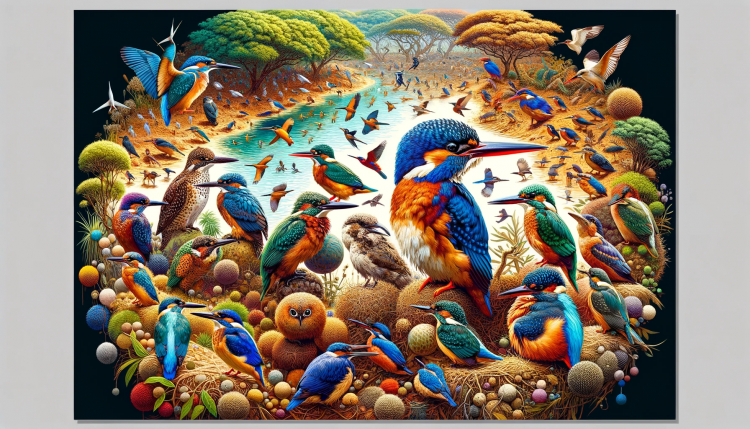

The Diverse World of Kingfishers
Kingfishers are a testament to nature’s creativity, showcasing a remarkable variety of species, each adapted to its unique lifestyle and habitat. Let’s take a flight around the world to appreciate the diversity of these spectacular birds.
A Global Family: The family Alcedinidae, to which kingfishers belong, is spread across the globe, with over 100 species. From the kookaburras of Australia to the tiny kingfishers of the African rainforests, each species has carved out its niche in the ecosystem.
Not Just Fishers: While the name ‘kingfisher’ suggests a diet predominantly of fish, these birds are incredibly diverse in their feeding habits. Some, like the Common Kingfisher and the Pied Kingfisher, are experts at aquatic hunting. Others, such as the Lilac-breasted Roller of Africa, primarily feed on insects and small vertebrates. This dietary diversity allows kingfishers to inhabit a variety of environments beyond just rivers and lakes.
Colors and Calls: The diversity of kingfishers isn’t just in their diet and habitat; it’s vividly apparent in their appearance and sounds. The plumage of kingfishers ranges from the shimmering blues and greens of the Asian and European species to the striking multicolored feathers of the American and African kingfishers. Their calls are equally varied, from the laughing chorus of the Laughing Kookaburra to the high-pitched whistle of the Oriental Dwarf Kingfisher.
Size and Shape: Kingfishers also vary greatly in size and shape. The Giant Kingfisher of Africa, weighing up to 355 grams, looks quite different from the diminutive African Pygmy Kingfisher, which barely tips the scales at around 12 grams. Each species’ physique reflects its lifestyle, whether it be diving into water, darting through dense forests, or hunting over open fields.
Adaptable Survivors: The adaptability of kingfishers is key to their diversity. Some species have adapted to life in urban settings, while others thrive in untouched wilderness. Their ability to exploit different food sources and habitats has enabled them to spread across diverse geographical landscapes.
The world of kingfishers is a vibrant mosaic of colors, sounds, and behaviors. This diversity not only makes them fascinating subjects of study but also vital components of the ecosystems they inhabit. As we journey through the habitats of these varied species, we gain a deeper appreciation for the intricate tapestry of life they represent.


Kingfishers in Ecosystems
More than just dazzling birds; Kingfishers play significant roles in their ecosystems. As we explore their interactions with the environment and other species, we’ll see just how integral these birds are to the natural world.
Indicators of a Healthy Environment: Often, the presence of kingfishers is a sign of a healthy ecosystem, particularly in aquatic environments. For example, seeing a Common Kingfisher darting along a river can indicate good water quality and an abundant fish population. They are, in a way, nature’s own quality control inspectors.
Predators and Prey: In the food chain, kingfishers hold an important place. As predators, they help regulate populations of fish, insects, and small vertebrates, maintaining a balance in the ecosystem. On the flip side, kingfishers themselves are prey for larger birds and mammals, contributing to the food web.
Seed Dispersal and Pollination: While not as prominent as other species in these roles, some kingfishers do contribute indirectly to seed dispersal and pollination through their droppings, especially those that consume fruits and insects among vegetation.
Habitat Engineers: Kingfishers, particularly those that excavate nest tunnels like the Belted Kingfisher in North America, can influence their habitats physically. These nesting activities can help shape riverbanks and promote soil aeration, benefiting other species and the overall health of the ecosystem.
Cultural and Ecological Importance: Beyond their ecological roles, kingfishers hold significant cultural and symbolic value in many societies. They inspire art and folklore, contributing to the cultural richness and biodiversity appreciation in human communities.
Impact of Environmental Changes: Kingfishers, with their specific habitat and dietary needs, are sensitive to environmental changes. Alterations in water quality, habitat destruction, and climate change can drastically affect their populations, making them important indicators for conservation efforts.
Kingfishers are not just solitary hunters or flashes of color along a waterway; they are active participants in their ecosystems. Their presence, behavior, and health reflect the state of their environment, making them crucial for ecological balance and indicators of environmental changes. As we look closer at these birds, we realize that they are deeply intertwined with the health and vitality of our natural world.


Conservation Status and Threats to Kingfishers
While kingfishers enchant us with their beauty and fascinating behaviors, they face numerous challenges that threaten their survival. Understanding these threats and their conservation status is crucial for ensuring that these birds continue to thrive.
A Spectrum of Conservation Statuses: Kingfishers, like all wildlife, are assessed for their conservation status by organizations like the International Union for Conservation of Nature (IUCN). While many species are considered of ‘Least Concern’, meaning they are currently stable, some are not so fortunate. Species like the Brazilian Kingfisher and the Sulawesi Dwarf Kingfisher are listed as ‘Vulnerable’, facing a higher risk of extinction in the wild.
Habitat Loss: One of the most significant threats to kingfishers is habitat loss. Deforestation, urban development, and changes in land use can destroy or fragment the habitats kingfishers need for hunting and nesting. This is especially critical for species that rely on specific environments, like dense forests or clean, flowing rivers.
Water Pollution: For those species that rely on aquatic environments, water pollution poses a serious threat. Pesticides, industrial waste, and other pollutants can not only reduce fish populations – the primary food source for many kingfishers – but also directly harm the birds through contamination.
Climate Change: The impacts of climate change, such as altered weather patterns and rising temperatures, can affect kingfishers. Changes in river flow, for example, can influence fish populations and, consequently, the food availability for aquatic kingfishers.
Human-Wildlife Conflict: In some areas, kingfishers can come into conflict with human interests. For instance, fishermen might view them as competition, leading to direct persecution in some cases.
Conservation Efforts: On a brighter note, there are various conservation efforts underway to protect kingfishers. These include habitat preservation and restoration, pollution control measures, and legal protections. Education and awareness campaigns also play a vital role in changing public perception and behavior towards these birds and their habitats.
Conservation Efforts and Future Outlook
The future of kingfishers hinges on our conservation efforts. Here’s a glimpse at what’s being done and what lies ahead:
- Habitat Protection and Restoration: Preserving natural habitats and restoring degraded ones are crucial for kingfisher survival.
- Pollution Control: Efforts to reduce water and land pollution directly benefit kingfisher populations.
- Climate Change Mitigation: Addressing the broader issue of climate change is essential for protecting kingfisher habitats long-term.
- Legal Protections: Implementing and enforcing laws to protect kingfishers from hunting and trading is vital.
- Community Involvement: Engaging local communities in conservation efforts helps create sustainable solutions.
Looking Ahead: The future outlook for kingfishers largely depends on our actions today. Continued focus on habitat conservation, pollution control, and climate action, combined with public education and involvement, is essential. With these efforts, we can hope for a future where kingfishers continue to thrive and enchant generations to come.
To sum it up, while kingfishers are generally resilient and adaptable birds, they face a range of threats that require our attention and action. By understanding these challenges and supporting conservation efforts, we can help ensure that kingfishers continue to grace our natural world with their presence and beauty.


Observing and Photographing Kingfishers
For birdwatchers and photographers, kingfishers present a delightful yet challenging subject. Here are some tips for those looking to observe or capture these elusive birds on camera:
- Know Their Habitat: Understanding where to find kingfishers is key. Look for them near water bodies for aquatic species, or in wooded areas for forest-dwelling types.
- Patience is a Virtue: Kingfishers can be shy and quick. Patience is essential, along with a quiet and non-intrusive approach.
- Use the Right Gear: A good quality camera with a long lens is ideal for photographing kingfishers, as it allows for detailed shots from a distance.
- Respect Their Space: Always maintain a respectful distance to avoid disturbing kingfishers, especially during breeding season.
- Learn Their Behavior: Understanding their hunting and perching patterns can help in anticipating the perfect shot.


Kingfishers in Culture and Folklore
Kingfishers hold a special place in the cultural tapestry and folklore of many societies around the world, symbolizing everything from love and happiness to prosperity and peace.
A Symbol of Peace and Prosperity: In many cultures, the kingfisher is seen as a bearer of good luck and tranquility. The sight of a kingfisher was often considered a good omen, signaling the arrival of a peaceful or prosperous period.
Ancient Mythologies: In Greek mythology, the kingfisher is associated with Alcyone, who was transformed into a bird. The ‘Halcyon days’, a term still used today to denote a peaceful time, originates from the myth that the seas would remain calm during the kingfisher’s nesting period.
Artistic Inspiration: The vibrant colors and graceful form of kingfishers have inspired artists for centuries. From ancient Egyptian tomb paintings to modern digital art, the kingfisher has been a subject of admiration and artistic expression.
Folklore and Stories: In many folk tales, the kingfisher is portrayed as a wise and knowledgeable character, often helping others with its insight. These stories often highlight the kingfisher’s keen hunting skills and vibrant appearance.
Cultural Significance Across Continents: In Asian cultures, kingfishers are often associated with love and fidelity, while in some Native American traditions, they are seen as symbols of luck and good fortune. In Europe, the kingfisher has been featured in literature and poetry, admired for its beauty and solitary nature.
Kingfishers in Literature: The bird has been a subject in the works of famous authors and poets, who have marveled at its beauty and used it as a metaphor for various human emotions and experiences.
Kingfishers are not just remarkable for their ecological roles; they also hold a significant place in the cultural and spiritual lives of people around the world. Their representation in culture and folklore underscores the deep connection between humans and the natural world, reminding us of the beauty and inspiration we draw from wildlife.
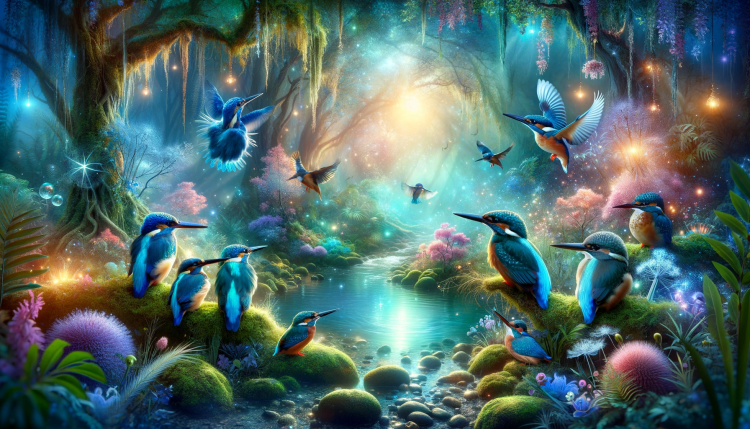

The Enchanting World of Kingfishers
As we come to the end of our journey through the captivating world of kingfishers, it’s clear that these birds are more than just a fleeting splash of color in our waterways and forests. They are a window into the incredible diversity and resilience of nature.
From the solitary hunter skimming over a crystal-clear stream to the family groups of kookaburras laughing in the dawn light, kingfishers bring a unique beauty and vitality to their habitats. Their varied behaviors, diets, and breeding rituals reveal a complex and fascinating avian world. But perhaps more importantly, kingfishers remind us of our connection to the natural world and our responsibility to protect and preserve it.
Their presence across cultures as symbols of peace, prosperity, and good fortune speaks to the universal appeal of these birds. They inspire artists, excite birdwatchers and photographers, and play crucial roles in their ecosystems. Yet, they face challenges – from habitat loss and pollution to the broader impacts of climate change – that threaten their survival.
In the end, the story of kingfishers is not just about the birds themselves but also about us. It’s a story of how we interact with our environment, the importance of conservation efforts, and the need for a sustainable coexistence with nature. As we continue to be fascinated and inspired by these brilliant birds, let’s also commit to ensuring that kingfishers, and the diverse ecosystems they represent, thrive for generations to come.





